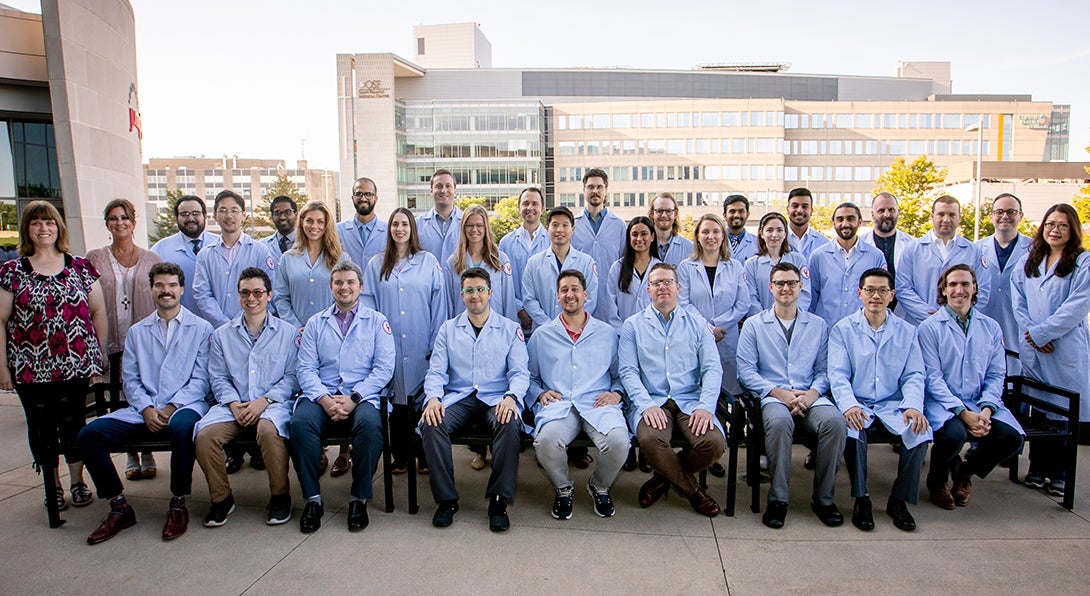Diagnostic Radiology Residency

The University of Illinois College of Medicine Peoria (UICOMP) residency in Diagnostic Radiology is an ACGME-accredited comprehensive teaching program providing well-rounded and practical training.
The program is entirely conducted at the OSF Saint Francis Medical Center that includes the 649-bed adult hospital that receives over 60% of all community admissions from the 402,391 population Peoria metropolitan area and serves as the Level I Trauma Center and tertiary referral hospital for 26 counties, 2.25 million people, in north central Illinois. The attached 144-bed Children’s Hospital of Illinois, the only dedicated children’s hospital in downstate Illinois, completes the clinical resources that assure our residents have exposure to all clinical scenarios and disease processes needed for a comprehensive education in Diagnostic Radiology.
Our residency program also has an approved ESIR program and an Independent IR/DR residency, which started on July 1, 2020. Our intention is to fill our Independent IR/DR residency from our ESIR program.
Links Heading link
Inside the Diagnostic Radiology Residency Heading link
Meet Our Leadership Heading link
Kevin M. Fahey
Jane Maksimovic
Tim Fahey
Amanda Hicks
Phone:
Email:
Research Heading link
The residents are required to initiate and complete at least one project in basic and/or clinical research. Residents are encouraged to prepare the results of their projects for presentation at regional or national radiology conferences as well as for articles submitted for publication in refereed journals. Approved resident presentations at a regional or national meeting will be fully funded by the department.
Each year $10,000 is available from the institution solely to fund resident research projects. Awards are made through the Graduate Medical Education Resident Research Sub-committee after evaluating all applications for merit.
While all areas are involved to some extent in research, the majority of the research is in the areas of Neuroradiology, Vascular/Interventional Radiology, and Breast Imaging.
Facilities and equipment Heading link
The Department of Radiology annually performs more than 300,000 diagnostic imaging studies of all types at OSF HealthCare Saint Francis Medical Center and six outpatient centers. In addition to the main campus, our faculty and residents give subspecialty reads of studies from other OSF HealthCare sister hospitals for a total of 730,000 studies.
JUMP Simulation also offers academic and training opportunities, including ultrasound simulations, contrast reaction simulations and more.
Resident benefits Heading link
Our program provides many benefits to our residents including:
- Custom lead aprons
- iPads to use for the 4 years of radiology residency
- Paid tuition for the ACR Institute for Radiologic Pathology (AIRP) conference
- $1,200 education reimbursement stipend per year
- Up to a week off per year to attend national/regional educational conferences
- Earned time off for RSNA conferences, resident wellness days, and the Christmas/New Year holiday block
- OSF HealthCare benefits
Residents also get access to the following:
- StatDx
- RadPrimer
- MedOne Radiology (all Thieme publications)
- Core Physics Review
- EPIC
- Hundreds of electronic textbooks
How to Apply Heading link
Our program participates in the National Residency Match Program (NRMP) via the Electronic Residency Application Service (ERAS). Each year, we accept up to six categorical positions.
Three letters of recommendation are required; you may submit up to four.
Provide your USMLE Step 1 or COMLEX Level 1 Pass/Fail result and USMLE Step 2 or COMLEX Level 2 score on your ERAS application.
Interviews
Applicants invited for an interview will be notified via Thalamus and email. Interviews are conducted during October, November and December.
Interviews will be virtual using Zoom. Please refer to your interview confirmation email for your specific interview schedule and details. Interviews are conducted with program leadership and faculty during morning sessions. A zoom social hour with all of the residents will take place after the morning sessions to end the interview day.
For more information about the program, email Program Coordinator, Amanda Hicks.
